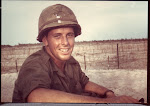HO CHI MINH
CITY: Nearly fifty years ago when the US
Marines landed on Red Beach in central Viet Nam, Saigon was a small city. Today
renamed Ho Chi Minh City, with a population of 8 million, it extends nearly 20
miles to the northwest to the town of Cu Chi.
This town is best known for the tunnel system that extended from the
Cambodian border to beneath the Presidential Palace in Saigon during the Viet
Nam War. It was the base camp the US
Army’s 25th Division. Nothing remains today except the tunnels which
are a main tourist attraction.
Traveling
along this highway towards Tay Ninh from Cu Chi are army veterans from the
Plattsburg, NY area. Corky Reinhart,
Neil Tallon and Pete Conroy guided by Omar Bui a former interpreter for the US
forces are driving towards the Black Virgin Mountain in Tay Ninh province. The stretch of highway passing through the
small town of Trang Bang is the site of one of the most iconic photos of the
Viet Nam war. Shot by AP photographer
Nick Ut ‘The Girl in the Picture’ Kim Phuc was fleeing from military action
when her group of children were mistaken for enemy forces and napalmed by
aircraft from the South Vietnamese Air Force.
Her family runs a small coffee shop and roadside memorial in that town.
 |
| Corky Reinhart, Omar Bui, Pete Conroy & Neil Tallon on the highway where Kim Phuc was struck by napalm. |
“You wonder
sometimes”, said Neil Tallon, two time candidate for US Congress, “how the US
could have used such a horrible weapon through-out this country….and why? And yet today we’re got the drones bombing in
Afghanistan”.
Looming over
three thousand feet in the distance shortly past Tay Ninh is ‘Nui Ba Den’, The
Black Virgin Mountain, an extinct volcano centered on a plain. Pete Conroy, a
soldier with the US Army’s 1st Cavalry Division was involved in
operations in this area during the fall of 1968.
“The word
was then,” he said, “that we controlled the top of the mountain, but the VC
(National Liberation Front Soldiers) always held the bottom and surrounding
plain. We flew on helicopters many times
through this vicinity”.
“There is a
theme park and a gondola system that takes people to the top these days” said
Omar. “This is the main tourist
attraction here besides the Cao Dai temple in Tay Ninh”
 |
| Corky Reinhart, Pete Conroy, Omar Bui & Neil Tallon with the Black Virgin Mountain in the background.. |
From Tay
Ninh the highway winds back easterly towards the 31,000 acre Michelin Rubber
Plantation which was the scene of many battles during the Viet Nam War. The historic record indicates that while this
plantation was a staging area for VC and NVA (North Vietnamese Army) operations
they were paid off by Michelin so the company could keep the rubber operation
running. The US government paid the
Michelin Company for any damages incurred by US military action.
“The orderly
plantings of these rubber trees brings to mind the end of the French Colonial
Empire”, said retired college professor Corky Reinhart.
“I was a
photo interpreter in Saigon during the war” said Neil Tallon, “and many times
I’ve viewed this area looking for evidence of VC or NVA activity from the
perspective of an aircraft flying at 10,000 feet. Whole battalions could operate under this
canopy with no one being the wiser when viewed from above”.
 |
| Pete Conroy and Corky Reinhart in the Michlin Rubber Plantation. |
Along the
outskirts of Cu Chi is a large military cemetery for the sons and daughters of
this community who died during the conflict.
The entrance monument, a large concrete mosaic somewhat resembling
Picasso’s ‘Guernica’ shows men, woman and children with guns and hand tools
toiling away for their cause.
“This
cemetery’s precisely ordered gravestones reminds me of our own Europe and
Asia,” said Neil Tallon. “These people
were their heroes who died driving out the foreign invader. A little like Iraq and Afghanistan; or for
that matter the War of 1812 in our area.
It all depends on the perspective.”
“What
impressed me, said Pete Conroy, “was the spread in ages on the
gravestones. From young teenagers to the
sixties. Most of our dead were of
draftee age, 18 to 22”.
This
secondary route back to Ho Chi Minh City eventually opens up on the new skyline
of a modern city. It no way resembles
the Saigon of the Sixties where the Caravelle Hotel at ten stories was the
tallest structure in town.
*A version of this article appeared in the Press Republican on March 28, 2014.

No comments:
Post a Comment